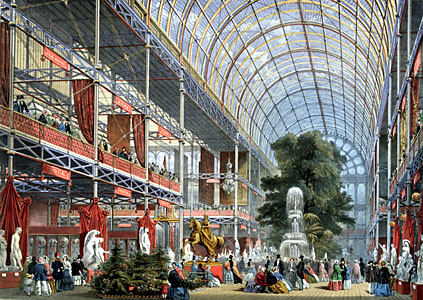During the late 19th century Britain was experiencing
a manufacturing boom which was caused by the industrial revolution. Queen’s Victoria’s
Husband, Prince Albert wanted to organise an exhibition which showcased the
wonders of modern industry and manufacturing which comes from all around the
world. This idea came in the ideal time of the industrial revolution to show
off the capabilities of modern manufacturing in international scale.
The Great exhibition needed a suitable place for the organisation
of this event. The government issued a competition for designer to design a
suitable venue to host this event. In the end there were 248 proposal plans for
the hosting building of the great exhibition but every one of them was rejected
by the building committee. The committee itself tried to design their own
version of the hosting building but their final design which was published in
May of 1850 was not suitable and ideal for this project. Their proposal would
have taken 15 months to build and needed around 15 million bricks for
construction. The scheduled date for the opening of the great exhibition was
1st May of 1851. With the design which was proposed by the committee it was almost
impossible to make it in time.
 |
| Joseph Plaxton initial drawings |
After the design was marked as inconvenient for the building
of the great exhibition another plan was introduced by another design. Joseph
Plaxton was a designer which was building greenhouses for the Duke of
Devonshire at Chatsworth during the time. His design was based on the design of
greenhouses which was proposed to be built by gigantic pre-fabricated
components. Apart from the reason of the construction material, the structure
of the crystal palace was going to be built in a shorter period of time.
The steel structure and prefabricated components can be
compared to the construction methods that architects and builders use today for
the fast growing city construction that is going on especially in major cities
around the world.
 |
The building of the Crystal Place was built from a skeleton made
of columns manufactured from cast iron with more cast iron structure support.
The components of the Crystal Palace were fabricated in Birmingham, A city
which was widely known for manufacturing during the Industrial Revolution. The
crystal palace used glass for its outer shell. The removal of tax on glass
which was removed a few years before the building of the industrial revolution,
made it easier and cheaper for the manufacturers to produce the amount of glass
needed for the Crystal Palace. The outer shell of the crystal palace used
300,000 sheets of glass for its construction.
 |
During the construction, the new technology in construction materials,
tools and machinery helped to ease the construction of the Crystal palace. The new
invention of the steam engine helped to further develop construction tools to
be used for construction. These developments can be considered as the beginning
of a long journey of technological upgrades when it comes to tools and machinery.
During the construction of the Crystal palace, the invention
of the telegraph was a key element during the time of construction. The telegraph
enabled rapid communication between the site of construction and the
manufacturers. In less than 9 months, the Crystal Palace rose and was ready for
exhibition over 100,000 objects during the great exhibition.
 |
 |
Reference :
The Crystal Palace - Victoria and Albert Museum. 2014. The Crystal Palace - Victoria and Albert Museum. [ONLINE] Available at:http://www.vam.ac.uk/content/articles/t/the-crystal-palace/. [Accessed 26 January 2014].
The Great Exhibition. 2014. The Great Exhibition. [ONLINE] Available at:http://www.bl.uk/learning/histcitizen/victorians/exhibition/greatexhibition.html. [Accessed 26 January 2014].
No comments:
Post a Comment